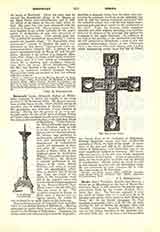

Bernard, Saint, thirteenth Bishop of Hildesheim, Germany, b. about the middle of the tenth century; d. November 20, 1022. He claimed descent from a noble Saxon family, which counted among its members men of distinction in Church and State. His grandfather was Athelbero, Count Palatine of Saxony. Having lost his parents at an early age, he came under the care of his uncle Volkmar, Bishop of Utrecht, who entrusted his education to Thangmar, the pious and learned director of the cathedral school at Heidelberg. Under this master, Bernward made rapid progress in Christian piety as well as in the sciences and in the liberal and even mechanical arts. He became very proficient in mathematics, painting, architecture, and particularly in the manufacture of ecclesiastical vessels and ornaments of silver and gold. He completed his studies at Mainz, where he was ordained priest by Archbishop Willigis, Chancellor of the Empire (975-1011). He declined a valuable preferment in the diocese of his uncle, Bishop Volkmar, and chose to remain with his grandfather, Athelbero, to comfort him in his old age. Upon the death of the latter, in 987, he became chaplain at the imperial court, and was shortly afterwards appointed by the Empress-Regent Theophano, tutor to her son Otto III, then six years of age. The youthful emperor is known to have been a learned and religious prince, for which he was indebted in no small degree to his instructor.
Bernward remained at the imperial court until 993, when he was elected Bishop of Hildesheim. His long episcopate of nearly thirty years was prolific of great results for the Diocese of Hildesheim. Thangmar, his former tutor, who subsequently became his biographer, describes in eloquent terms, how the saint, after performing his episcopal functions in the cathedral, was wont to visit the various workshops connected with the cathedral school, and with his own hands manufactured gold and silver vessels for the enrichment of the altars. Under his direction arose numerous churches and other edifices, including even fortifications for the defense of his episcopal city against the invasions of the pagan Normans. As evidences of his skill in the practice of the mechanical arts there are still preserved in Hildesheim a cross of rich and exquisite workmanship, known as the “Bernward Cross”, the famous Bernward column, with winding reliefs representing scenes from the life of Christ, two bronze doors of the Cathedral of Hildesheim, showing Scriptural scenes, and two candlesticks symbolic of Christ, the light of the world. A monument of his zeal and skill is St. Michael’s abbey-church at Hildesheim—now Protestant—one of the most magnificent basilicas in Germany. His knowledge and practice of the arts were wholly employed in the service of the Church. A man of extraordinary piety, he was much given to prayer and the practice of mortification. Shortly before his death in 1022 he had himself invested with the Benedictine habit. He was canonized by Pope Celestine III in 1193. His feast occurs on November 20.
J. A. BIRKHAEUSER

